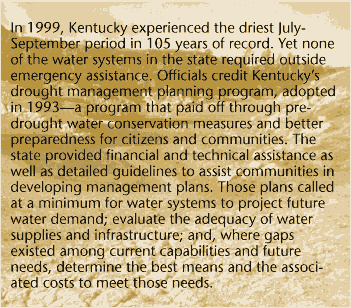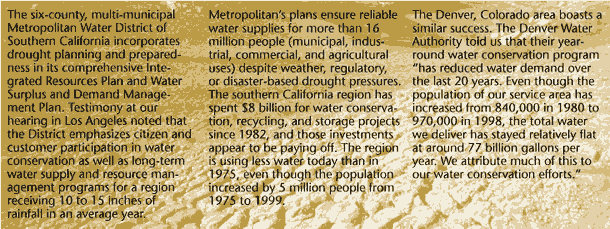|
|
|
| Return to Table of Contents | |
and the states." The two governors emphasized that such coordination is preferable to "new federal programs with regulatory authority over the states." Regional Entities There are several regional entities that either focus on drought or include drought as a major component of their work (Appendix B, File D). The Western Drought Coordination Council, for example, presented the Commission with a set of potential actions that focus on drought planning, impact-reduction measures, and effective response. And the Tarrant Regional Water District (Texas) incorporates simulated drought exercises as a training tool in its drought planning.
|
 |
| The Commission
received a number of comments that encouraged regional drought planning
or incorporation of drought concerns into comprehensive regional water
management plans. The comments echoed earlier recommendations of the
1990 National Science Foundation’s Drought Water Management Workshop.
Participants at the workshop concluded, "The real need is to
institutionalize drought management into improved overall water
management systems." They stated that attempts to understand and
address drought problems will be unsuccessful unless the larger context
of which they are an inseparable part is also understood and addressed.
The Army Corps of Engineers drew a similar conclusion in the first year
(1989) of the National Drought Study.
The regional approach has
been undertaken in the past and survives today. On June 14, 1965, during
the height of the 1960s drought in the Northeast, New York City stopped
releases from its Delaware River reservoirs to maintain its withdrawal
rate. With less fresh water flowing past Philadelphia, there was a risk
that salt water would be drawn into Philadelphia’s water supply
system. In August, President Lyndon Johnson convened a special meeting
of governors and mayors from the Delaware Basin that led to emergency
measures for managing the Delaware. The President then asked
Congress for |
|
 |
|
|
|
|
